Articular cartilage cannot be repaired directly but we can undertake various procedures that can help it to heal and repair itself. The simplest procedures involve inspecting the cartilage arthroscopically and removing loose fragments or smoothing down rough surfaces. This can be helpful in reducing symptoms of locking or giving way in the short term but does not really address the longer term problem of healing and repair of the surface. In some cases healing can be achieved by altering the mechanical environment. For example if there is abnormal loading of the cartilage surface in one area and we change the mechanics so that the load is more evenly distributed across a larger area there is the potential for a degree of healing to occur. We can do this for example by undertaking an osteotomy which means cutting the bone and usually changing its angle or position. This can redirect the forces so that less pressure occurs at the area of damage.
Unfortunately many patients present at the stage where the cartilage has worn right down to the underlying bone. When that happens there is really no prospect of new cartilage appearing on that bone surface without intervention surgically.
Mosaicplasty
This is a method whereby areas of good cartilage are moved from one part of the knee to another. We remove the cartilage from the less important parts of the bearing surface and then reintroduce them into the main weight bearing area that has been affected by severe wear.
|
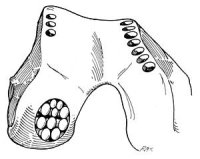
|
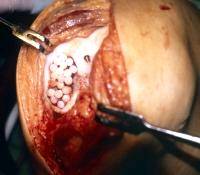
|
|
Plugs of cartilage and bone are moved from less important areas to the damaged main weight bearing areas
|
Mosaicplasty of the medial femoral condyle at surgery - note the multiple circular cartilage /bone plugs
|
This procedure is used uncommonly and now generally only for small deep defects. It is quite an invasive procedure and there are concerns about the amount of damage that occurs at the donor sites where the cartilage/bone plugs are removed from. If large areas are covered in this way there is quite a high incidence of problems.
Autologous chondrocyte implantation
In Autologous Chondrocyte Implantation (ACI) cartilage cells are removed from the knee at an arthroscopy operation and grown in the laboratory. The cells divide providing many new cells which can be used to resurface defects in the articular surface. It takes about 6 weeks to grow the new cells. At a second operation the cells are implanted through an open incision. There are a a number of ways in which the cells can be used. In one method a sheet of collagen is sutured over the cartilage defect and the cells are inserted beneath the collagen. In another technique the cells a cultured directly ono a collagen membrane and the mebrane with its attached cells are then fixed to the defect.
|
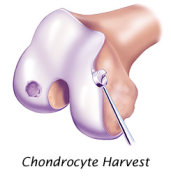
|

|
|
Cartilage being removed from the iedge of the joint to provide cells for culture
|
Cells being inserted beneath a layer of collagen which has been attached to the defect
|
We have been carrying out cartilage cell implants at London Knee Clinic for several years. However due to changes in legislation we are currently unable to offer this service. The technique is undergoing further development. It has certain disadvantages currently. Two or sometimes three separate operations are required and it is currently quite an expensive technique requiring special equipment. We are therefore currently using an alternative similar method of treament using a synthetic material known as Chondrotissue. Further imformation will be available on this website shortly.
Microfracture
In microfracture several small holes are drilled into the bone at the site of the cartilage damage. This allows blood to escape from the underlying bone marrow carrying with it stem cells that are able to transform into mature fibrocartilage. Fibrocartilage is similar in some ways to the hyaline cartialge it replaces but it is not such a good bearing surface.
|
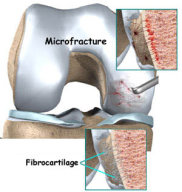
|
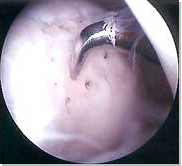
|
|
Technique of microfracture
|
Arthroscopic view of microfracture
|
Microfracture is frequently performed in the treatment of small to moderate patches of cartilage damage. It is a straightforward technique that can be done arthroscopically and is a one-step procedure unlike ACI which needs a minimum of two operations, It is also significantly less expensive to perform.
Arthroplasty
If cartilage damage is severe there may be very little else that can be done other than to resurface the bone using metal, plastic or ceramic materials.
Choice of procedure
With small to medium areas of superficial damage microfracture is probable the most suitable technique but single plugs of cartilage and bone may still be useful as a technique where there is a relatively small area of deep bone loss. ACI is still under development and is a promising way of dealing with fairly large defects. It does however have its own problems. For example there really has to be a good rim of normal cartilage around the area being grafted which makes it difficult to use for lesions on the edge of the articular surface.
TEXT Copyright London Knee Clinic ®2014